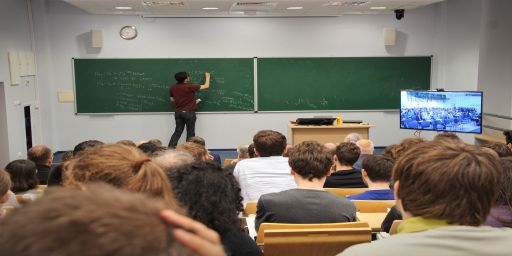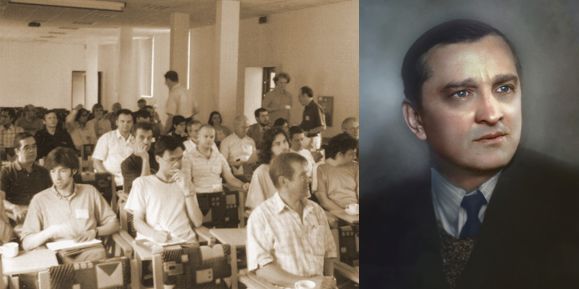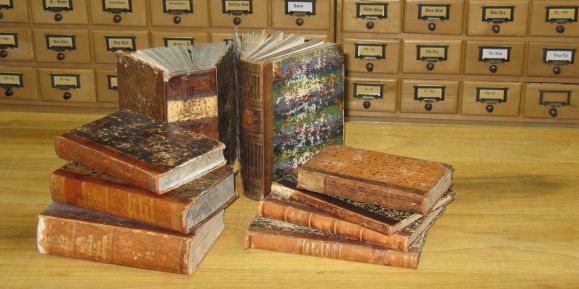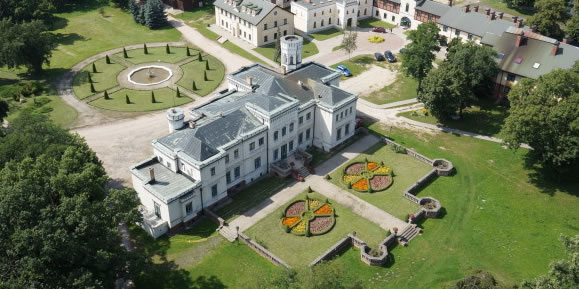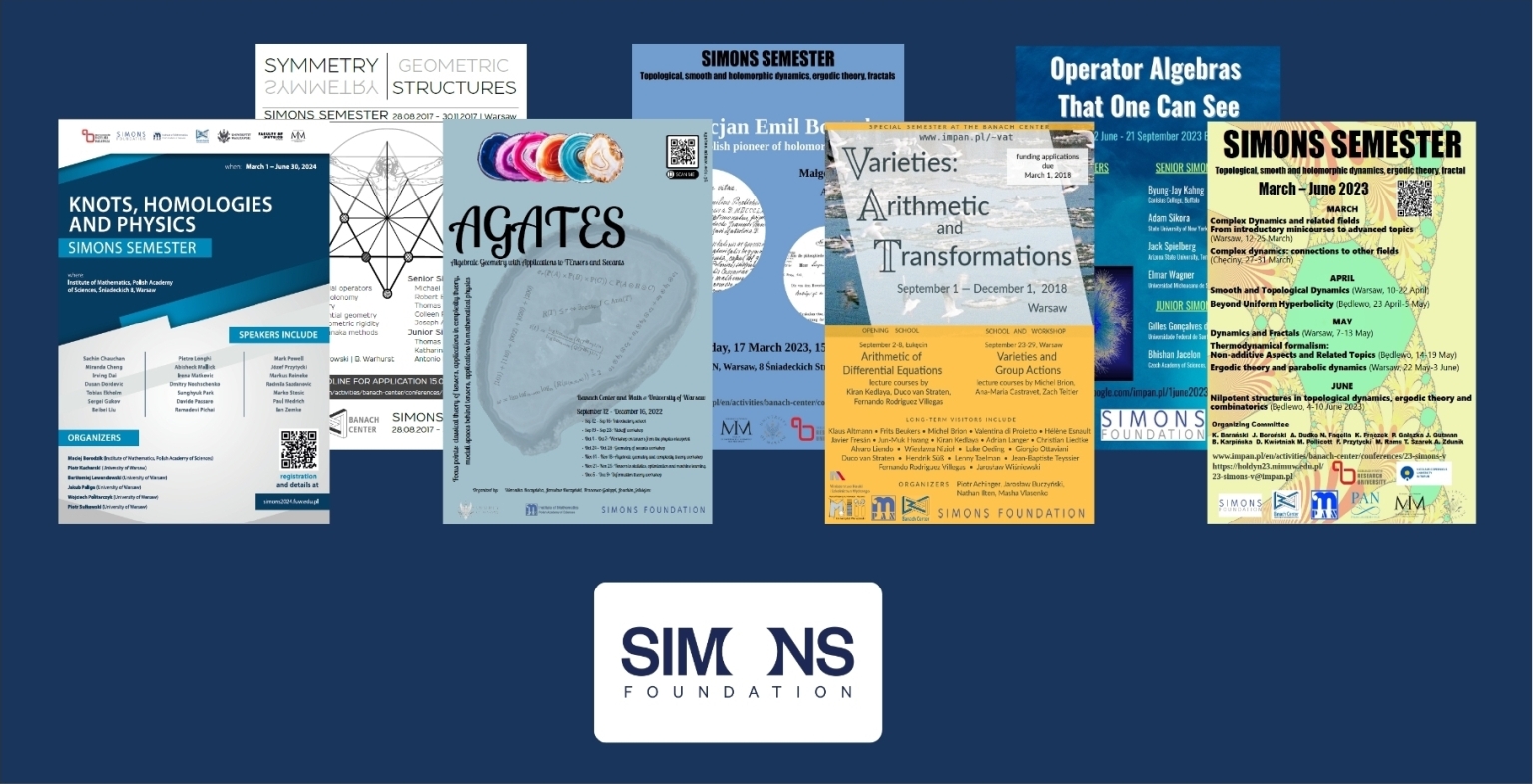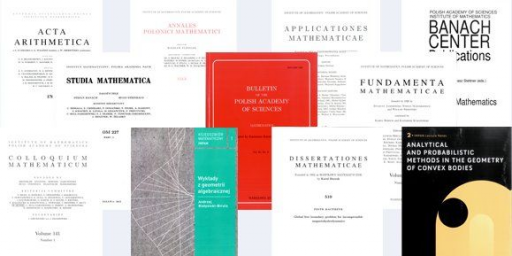Instytut Matematyczny Polskiej Akademii Nauk / Institute of Mathematics / Activities / Seminars in IMPAN / Noncommutative geometry
Academic year 2017/2018
2 October 2017, 10:30-12:00
RANK-TWO MILNOR IDEMPOTENTS FOR THE MULTIPULLBACK QUANTUM COMPLEX PROJECTIVE PLANE
The K0-group of the C*-algebra of the multipullback quantum complex projective plane is known to be Z3, with one generator given by the C*-algebra itself, one given by the section module of the noncommutative (dual) tautological line bundle, and one given by the Milnor module associated to a generator of the K1-group of the C*-algebra of the Calow-Matthes quantum 3-sphere. In this talk, we outline a proof that these Milnor modules are isomorphic either to the direct sum of section modules of the noncommutative tautological and dual tautological line bundles, or to a complement of this sum in the rank-four free module. We also argue that the direct sum of these noncommutative line bundles is a noncommutative vector bundle associated to the SUq(2)-prolongation of the Heegaard quantum 5-sphere S5H viewed as a U(1)-quantum principal bundle. Finally, we demonstrate that the above Milnor modules always split into the direct sum of the rank-one free module and a rank-one non-free projective module that is not associated with S5H. Based on joint work with Carla Farsi, Tomasz Maszczyk and Bartosz Zieliński.
PIOTR M. HAJAC (IMPAN)
2 October 2017, 14:00-15:30
ON THE QUANTUM ROSENBERG CONJECTURE
The classical Rosenberg conjecture states that the reduced group C*-algebra of a discrete group is quasidiagonal if and only if the group itself is amenable. The conjecture was proved in the 2017 Annals paper of Tikuisis, White and Winter. Recently, Dadarlat and Sato improved this result by proving it without the UCT assumption. In this talk, we use the Dadarlat-Sato approach to obtain an analogous result for discrete unimodular quantum groups.
ADAM SKALSKI (IMPAN)
9 October 2017, 10:30-12:00
AROUND PROPERTY (T) FOR QUANTUM GROUPS
Kazhdan's Property (T) for quantum groups was introduced by Fima, and later studied by Kyed, Sołtan, Li, Ng, Arano and others. Here I will discuss recent related developments, especially concerning connections between property (T) and Bekka and Valette's property (T){1,1}. These turn out to be equivalent for discrete unimodular quantum groups. I will present the consequences of this result for 'typical' representations (à la Kerr-Pichot) and operator ergodic theory (à la Connes and Weiss). This is based on joint work with Daws and Viselter, and on recent results of Brannan and Kerr.
9 October 2017, 14:00-15:30
THE INVARIANCE OF HOCHSCHILD AND CYCLIC HOMOLOGY UNDER ROW EXTENTIONS
Goodwillie’s theorem states that the periodic cyclic homology is invariant under nilpotent extensions. We introduce a special type of nilpotent extensions of unital algebras (called row extensions) for which we prove a stronger result: the invariance of Hochschild and cyclic homology. The row extensions appear in abundance. They are always H-unital but generically non-unital and noncommutative. A very specific type of a row extension appears naturally in the construction of the Chern-Galois character. If P is an algebra with a principal coaction, and B is its coaction-invariant subalgebra, then the Chern-Galois character factors through the row extension of B by the nilpotent ideal consisting of the invariant universal differential one-forms on P. When P is a principal comodule algebra, one can identify this ideal with the kernel of the multiplication map restricted to the algebra of the associated Ehresmann-Schauenburg quantum groupoid. Based on joint work with Piotr M. Hajac.
TOMASZ MASZCZYK (Uniwersytet Warszawski)
16 October 2017, 10:30-12:00
(CO)HOMOLOGY OF TOPOLOGICAL ALGEBRAS VIA COALGEBRAS
Abrams and Weibel proved that continuous cohomology of profinite algebras with their natural topology can be calculated from the ordinary (co)algebraic cohomology of certain coalgebras, thus circumventing topological considerations. We are going to investigate how this result can be used to calculate continuous cohomology of a class of topological algebras that manifest themselves as the dual of incidence coalgebras. (This is a joint work with M. Kanuni and S. Sutlu.)
ATABEY KAYGUN (Istanbul Technical University)
16 October 2017, 14:00-15:30
ON FILTRATION-PRESERVING QUANTUM SYMMETRY GROUPS OF NONCOMMUTATIVE TORI
We will present necessary conditions for the existence of an action of a compact quantum group on the noncommutative n-torus Tnθ that preserves (in the sense of T. Banica and A. Skalski) a filtration orthogonal with respect to a given state. Then we will construct a family of compact quantum groups Gnθ such that, for all θ, the quantum group Gnθ is the final object in the category of all compact quantum groups acting on Tnθ in a filtration preserving way. We shall describe the structure of the C*-algebra of Gnθ, and discuss the representation theory of Gnθ. Joint work with M. Marciniak.
MICHAŁ BANACKI (Universytet Gdański)
23 October 2017, 10:30-12:00
INVARIANT MARKOV SEMIGROUPS ON QUANTUM HOMOGENEOUS SPACES
First, we show how to classify the convolution semigroups of states and the semigroups of G-invariant Markov operators on quantum spaces with an action of a compact quantum group G. Then, we discuss three types of spheres that are homogeneous spaces of quantum orthogonal groups ONx as examples. Furthermore, given ONx-invariant Markov operator semigroups on these spheres, (Tt) with t greater or equal to zero, we calculate eigenvalues of their generator operators. The eigenvalues are described by some orthogonal polynomials.
XUMIN WANG (Université de Franche-Compté)
23 October 2017, 14:00-15:30
KAZHDHAN PROPERTY (T) FOR QUANTUM GROUPS: SUMMARY AND NEW RESULTS
The discovery of Property (T) was a cornerstone in group theory, and the last decade saw its importance in many different subjects like ergodic theory, abstract harmonic analysis, operator algebras, and some of the very recent topics like C*-tensor categories. It is quite natural to explore the possibility of extending the notion of Property (T) to the realm of quantum groups. This was done in the following sequence: first within the framework of Kac algebras, then for algebraic quantum groups and discrete quantum groups, and finally for locally compact quantum groups by Joita, Petrescu, Fima, Soltan, Kyed, Skalski, Viselter, Daws, Brannan and Kerr. Thus far Property (T) has been mainly studied for quantum groups with the trivial scaling automorphism group. A recent result of Y. Arano states that the Drinfeld quantum double of the Woronowicz compact quantum group SUq(2n+1) has Property (T), thus producing a concrete example of a quantum group with non-trivial scaling automorphism group which has Property (T). This necessitates the need to generalize the results obtained before for quantum groups with the trivial scaling action to quantum groups non-trivial scaling actions. In this talk, our main objective is to push forward the methodologies and techniques developed in all the above-mentioned previous works about Property (T) to accommodate some quantum groups with non-trivial scaling action, thereby complementing the previously obtained results. Based on an ongoing joint work with P. Salmi.
BISWARUP DAS (Uniwersytet Wrocławski)
18 December 2017, 10:30-12:00
MATRICIAL STABILITY FOR COMMUTATIVE C*-ALGEBRAS
All known results about matrices almost commuting with respect to the operator norm are partial answers to the following open question: which commutative C*-algebras C(X) are matricialy stable? We answer this question under the assumption that X has finite covering dimension. This result is obtained by working out new permanence results for matricial stability, and by proving a purely topological result about finite-dimensional spaces, which can be of independent interest. To end with, we will discuss applications of the main result. Based on joint work with Dominic Enders.
TATIANA SHULMAN (IMPAN)
18 December 2017, 14:00-15:30
STRICT INCREASING APPROXIMATE UNITS OF C*-ALGEBRAS
It is well known that every C*-algebra has an increasing approximate unit with respect to the usual partial order on the positive unit ball. We consider the strict order << instead, where a << b means a = ab. Here again it is well known that every separable or σ-unital C*-algebra has a <<-increasing approximate unit, but the general case remained unresolved. In this talk, we outline our recent work showing that this extends to Ω1-unital C*-algebras but not, in general, to Ω2-unital C*-algebras. In particular, we consider C*-algebras defined from Kurepa trees which are scattered, and hence LF but not AF in the sense of Farah and Katsura. It follows that whether all separably representable LF-algebras are AF is independent of ZFC. (Based on joint work with Piotr Koszmider.)
TRISTAN BICE (IMPAN)
8 January 2018, 10:30-12:00
LOCAL TRIVIALITY FOR ACTIONS OF COMPACT QUANTUM GROUPS
In noncommutative geometry, there is no straightforward generalization of the concept of local triviality of a principal bundle because it is not clear how to define an open cover. In the compact case, one can get away by using finite closed covers to define piecewise triviality. The latter is only slightly more general than local triviality, and works well in the noncommutative setting through multi-pullbacks of unital C*-algebras. However, the multi-pullback construction does not work for simple C*-algebras. As a remedy, we introduce a definition of local triviality for actions of compact quantum groups on unital C*-algebras. It is inspired by the Rokhlin dimension used in and around the classification of unital simple separable nuclear C*-algebras. We show that, for commutative C*-algebras, our definition recovers the standard definition of local triviality of compact principal bundles. We also prove that locally trivial actions of compact quantum groups are automatically free. Finally, we apply this new notion to make progress with the noncommutative Borsuk-Ulam-type conjecture: we prove that it holds for actions of compact quantum groups with a classical subgroup whose induced action is locally trivial. Based on joint work with Eusebio Gardella, Piotr M. Hajac and Jianchao Wu.
MARIUSZ TOBOLSKI (IMPAN / Uniwersytet Warszawski)
15 January 2018, 10:30-12:00
STRING THEORY, K-HOMOLOGY AND THE HOPKINS-HOVEY THEOREM
K-homology (i.e. the dual theory to K-theory) can be defined in three ways: via homotopy theory, via geometric cycles, and (following Atiyah and Kasparov) via functional analysis. The same is true for twisted K-homology. This talk will give the geometric-cycle definition of twisted K-homology. The main result will be proved (using homotopy theory) as a corollary of a twisted version of the Hopkins-Hovey theorem. Also explained in the talk, will be the connection to the D-branes of string theory and how twisted K-homology provides a general setting for twisted index theory. Joint work with Alan Carey, Michael Joachim, Mehdi Khorami, Thomas Schick and Bai-Ling Wang.
PAUL F. BAUM (Penn State / IMPAN)
15 January 2018, 14:00-15:30
THE GROMOV-HAUSDORFF DISTANCE FOR HILBERT MODULES WITH A CONNECTION
Motivated by the quest for an analytic framework to study classes of C*-algebras and associated structures as geometric objects, we introduce a metric on Hilbert modules equipped with a generalized form of a connection. Thus we extend Gromov-Hausdorff convergence theory to vector bundles and quantum vector bundles in terms of their projective-module structure. Our metric is new even in the classical setting, and creates a framework for the study of the moduli spaces of modules over C*-algebras from the metric perspective. We apply our construction, in particular, to the continuous field of Heisenberg modules over quantum 2-tori.
FRÉDÉRIC LATRÉMOLIÈRE (University of Denver)
22 January 2018, 10:30-12:00
VECTOR BUNDLES OVER MULTIPULLBACK QUANTUM COMPLEX PROJECTIVE SPACES
In noncommutative geometry, finitely generated projective modules over a C*-algebra A are viewed as quantum vector bundles, and are classified up to stable isomorphism essentially by the positive cone of K0(A). In this talk, we focus on the C*-algebras of multipullback quantum odd spheres and multipullback quantum complex projective spaces. The K-groups of these C*-algebras were recently computed, and now it is natural to seek the classification of vector bundles over these quantum spaces. To tackle such a problem for C*-algebras in general, Rieffel developed very useful notions and properties of stable ranks. Following an approach popularized by Curto, Muhly, and Renault, we first realize the above sphere and projective-space C*-algebras as groupoid C*-algebras thus obtaining a convenient context for discussing projections over them. Then we apply Rieffel's theory of stable ranks to derive some answers regarding the classification of finitely generated projective modules. In particular, we identify the quantum line bundles over multipullback quantum projective spaces that are associated to multipullback quantum odd spheres with concrete elementary projections.
ALBERT SHEU (University of Kansas)
22 January 2018, 14:00-15:30
ON K-THEORY AND CUNTZ SEMIGROUPS OF C*-ALGEBRAIC QUANTUM GROUPS
A central aim of the classification program for C*-algebras is to provide existence theorems lifting isomorphisms of K-groups or Cuntz semigroups to C*-algebra isomorphisms. In this talk, we explain the theory of product operations on the Cuntz semigroups of C*-algebraic quantum groups. This sometimes allows one to improve existence results from C*-algebraic classification theory by providing bi-isomorphisms of C*-algebraic quantum groups. We end by discussing the computation of some Cuntz semigroups.
DAN KUCEROVSKY (University of New Brunswick at Fredericton)
19 February 2018, 10:30-12:00
AN EQUIVARIANT PUSHOUT STRUCTURE OF THE VAKSMAN-SOIBELMAN QUANTUM ODD SPHERES
Presenting the C*-algebras C(S2n+1q) and C(B2nq) of the Vaksman-Soibelman quantum (2n+1)-sphere and the Hong-Szymański quantum 2n-ball as graph C*-algebras, we unravel a U(1)-equivariant pullback structure of the former. As a main application, we prove that the generators of the even K-group of the quantum complex projective space CPnq are given by the Milnor connecting homomorphism applied to the (unique up to sign) generator of K1(C(S2n-1q)) and by the generators of K0(C(CPn-1q)). (Joint work with Francesco D'Andrea and Mariusz Tobolski.)
PIOTR M. HAJAC (IMPAN)
19 February 2018, 14:00-15:30
GENERALIZED STONE DUALITY BETWEEN ÉTALE GRUPOIDS AND INVERSE SEMIGROUPS
Research over the past few decades has revealed various connections between C*-algebras, étale groupoids and inverse semigroups which, in turn, arise naturally from objects like directed graphs and dynamical systems. More recently, people like Lawson and Kudryavtseva have honed in on some more precise Stone dualities between zero-dimensional locally compact Hausdorff étale groupoids and Boolean inverse semigroups. We show how to extend this further to non-zero-dimensional locally Hausdorff locally compact étale groupoids while still obtaining a duality with an elementary class of inverse semigroups. (Joint work with Charles Starling.)
TRISTAN BICE (IMPAN)
26 February 2018, 10:30-12:00
LATTICE OF IDEMPOTENT STATES ON A LOCALLY COMPACT QUANTUM GROUP
Idempotent states on locally compact quantum groups can be interpreted as generalizations of compact quantum subgroups. I will describe the operations on the set of idempotent states corresponding to the intersection of subgroups and forming the subgroup generated by two subgroups. Then we will shift attention to those idempotent states which should describe an open compact subgroup. We will show that there is an interesting duality between such states on a given locally compact quantum group and those on its dual, and then use it to prove several facts about idempotent states on compact quantum groups. (Joint work with P. Kasprzak.)
PIOTR M. SOŁTAN (Uniwersytet Warszawski)
26 February 2018, 14:00-15:30
HOPF-CYCLIC HOMOLOGY OF NONCOMMUTATIVE INSTANTONS
For noncommutative principal bundles corresponding to Hopf-Galois extensions, Jara and Ştefan established an isomorphism between the relative cyclic homology and the cyclic dual of Hopf-cyclic homology with appropriate stable-anti-Yetter-Drinfeld coefficients. However, interesting noncommutative deformations of principal bundles, such as the quantum circle bundles over Podleś spheres and the quantum instanton bundle coming from the Vaksman-Soibelman 7-sphere, go beyond the Hopf-Galois framework. In this talk, we show how to replace the Jara-Ştefan construction in the setting of module-coalgebra Galois extensions, and then instantiate it on the aforementioned examples. (Joint work with S. Sütlü.)
TOMASZ MASZCZYK (Uniwersytet Warszawski)
5 March 2018, 10:30-12:00
NUCLEAR DIMENSION AND Z-STABILITY
The nuclear dimension of a C*-algebra, introduced by Winter and Zacharias, is a non-commutative generalisation of the covering dimension of a topological space. Finite nuclear dimension, which is a strengthening of nuclearity, has good permanence properties and plays a crucial role in the Elliot Classification Programme. In this talk, I shall discuss the conjectured relationship between finite nuclear dimension and other regularity properties (The Toms-Winter Conjecture) and explain the recent work of myself, Castillejos, Tikuisis, White and Winter on the nuclear dimension of C*-algebras that absorb the Jiang-Su algebra tensorially.
SAMUEL EVINGTON (IMPAN)
5 March 2018,14:00-15:30
APERIODICITY, TOPOLOGICAL FREENESS AND PURE OUTERNESS: FROM GROUP ACTIONS TO FELL BUNDLES
Deep results connecting non-triviality conditions for group actions and simplicity of reduced crossed products were proved around 1980 by Olesen-Pedersen, Kishimoto and Rieffel. Their role in the analysis of crossed products cannot be overstated, but they are hardly accessible to non-experts, as they have not been systematically compiled. In this lecture, we systematize the knowledge about different non-triviality conditions for group actions. We improve some of the classical results and explain the major role of aperiodicity, topological freeness and pure outerness in the play. Finally, we show how to transfer these notions and the corresponding results to the realm of Fell bundles over discrete groups. (Based on joint work with Ralf Meyer.)
BARTOSZ KOSMA KWAŚNIEWSKI (Uniwersytet w Białymstoku)
12 March 2018, 10:30-12:00
In recent work on the structure of simple nuclear C*-algebras, tracial approximation and von Neumann algebraic techniques have proved indispensable. When the C*-algebra has a unique trace, this amounts to considering the enveloping von Neumann algebra coming from the GNS representation for the trace. More generally, one must consider the uniform tracial completion of the C*-algebra. When the extreme traces form a compact set, the uniform tracial completion has a bundle-like structure and can be studied using Ozawa's W*-bundles. This talk will cover my work on W*-bundles and recent work of myself, Castillejos, Tikuisis, White and Winter, where we develop a theory of complemented partitions of unity (CPoU) that allows us to understand the structure of uniform tracial completions without need for further assumptions on the trace simplex of the C*-algebra.
SAMUEL EVINGTON (IMPAN)
12 March 2018, 14:00-15:00
THE GAUSS-BONNET THEOREM FOR MATRIX CONFORMALLY RESCALED DIRAC OPERATORS
We derive an explicit formula for the scalar curvature over a two-torus with a Dirac operator conformally rescaled by a globally diagonalizable matrix. We show that the Gauss-Bonnet theorem holds, and extend the result to all Riemann surfaces with Dirac operators modified in the same way.
ANDRZEJ SITARZ (Uniwersytet Jagielloński / IMPAN)
19 March 2018,10:30-12:00
UNIVERSAL QUANTUM GROUPS, LÉVY PROCESSES AND COHOMOLOGY
Cohomological information about a compact quantum group G helps in constructing and classifying Lévy processes on G. In particular, if the second Hochschild cohomology group of its Hopf algebra Pol(G) with the trivial bimodule of coefficients given by the counit vanishes, then any generator of a Lévy process decomposes into the maximal Gaussian part and the remaining term, in analogy to the famous Lévy-Khintchine formula. In this talk, I will describe the first and second cohomology of the unitary and orthogonal universal quantum groups UF+ and OF+, and discuss the problem of determining which of these quantum groups admit the Lévy-Khintchine-type decomposition. Joint work with B. Das, U. Franz and A. Skalski.
ANNA WYSOCZAŃSKA-KULA (Uniwersytet Wrocławski)
19 March 2018,14:00-15:30
FINITE NON-COMMUTATIVE SPECTRAL TRIPLES FOR THE TORUS
Finite real spectral triples are defined to characterise the non-commutative geometry of a fuzzy torus. The geometries are the non-commutative analogues of flat tori with moduli determined by integer parameters. Each of these geometries has four different Dirac operators, corresponding to the four spin structures on a torus. The spectrum of the Dirac operator is calculated: it is given by the quantum integer analogue of the spectrum of the corresponding commutative torus.
JAMES GAUNT (University of Nottingham)
14 May 2018, 10:30-12:00
THE LARSON-SWEEDLER THEOREM FOR HOPF CATEGORIES
The famous Larson-Sweedler theorem for Hopf algebras states that any finite-dimensional Hopf algebra is a Frobenius algebra and, conversely, any finite-dimensional bialgebra with a faithful (left) integral is a Hopf algebra. We present a generalization of this theorem to Hopf categories. A Hopf category can be understood as a multi-object version of the usual notion of a Hopf algebra in the same way as a (small) k-linear category can be seen as a multi-object version of an algebra. Moreover, Hopf categories can lead to examples of weak (multiplier) Hopf algebras. An advantage of working with Hopf categories rather than weak (multiplier) Hopf algebras is that Hopf categories allow one to “see” the internal algebraic structure of the corresponding weak (multiplier) Hopf algebra.
JOOST VERCRUYSSE (Université Libre de Bruxelles)
14 May 2018, 14:00-15:30
LARGE APPROXIMATELY FINITE-DIMENSIONAL OPERATOR ALGEBRAS
A C*-algebra is called approximately finite dimensional (AF) if it contains a directed family of finite-dimensional subalgebras with norm dense union. We will discuss diverse phenomena which can occur for nonseparable AF C*-subalgebras of B(H), where H is a separable Hilbert space. The condition AF in the nonseparable context is not equivalent, like in Bratteli's 1972 separable result, to the possibility of approximating elements from a finite-dimensional subalgebra, as shown by Farah and Katsura in 2010. For example, basic permanence properties of the stability of AF algebras, which hold by classical theorems of Blackadar (1980) or Hjelmborg and Rordam (1998) for separable AF algebras, fail in a spectacular way for nonseparable algebras: there is an essential extension of the algebra of all compact operators on a nonseparable Hilbert space by the algebra of all compact operators on a separable Hilbert space which is nonstable for the reason that its multiplier algebra is just its unitization. Moreover, most fundamental uncountable inductive limits of separable AF stable ideals may not be stable, etc. The constructions of these examples are manifestations of some more general themes in combinatorial and descriptive set theory. The talk is based on joint papers with S. Ghasemi and C. Hida.
PIOTR KOSZMIDER (IMPAN)
21 May 2018, 10:30-12:00
FREE ENTROPY DIMENSION AND THE ORTHOGONAL FREE QUANTUM GROUPS
The von Neumann algebras associated with orthogonal free quantum groups have been intensively studied in the past decade and share many properties with free-group factors. In joint work with Michael Brannan, we show that these von Neumann algebras are not isomorphic to free-group factors by using tools from free probability and a quantum analogue of the Cayley graph. I will review these tools and show how they interact to obtain the non-isomorphism result.
ROLAND VERGNIOUX (Université de Caen Normandie)
28 May 2018, 10:30-12:00, room 403
INERTIA GROUPOIDS AND THEIR SINGULARITY STRUCTURE OR WHY WE NEED A CONCEPT OF STRATIFIED GROUPOIDS
The inertia space of a compact Lie group action or, more generally, of a proper Lie groupoid, has an interesting singularity structure. Unlike the quotient space of the group action, respectively the groupoid, the inertia space cannot be stratified by orbit types, in general. In this talk, we explain this phenomenon. Moreover, we show that it leads naturally to the concept of a stratified groupoid which lies in between the one of a Lie groupoid and the one of a topological groupoid. Finally, we show that a de Rham theorem holds for inertia spaces, and indicate a connection between the inertia space and the non-commutative geometry of the underlying groupoid in terms of basic relative Grauert-Grothendieck forms on the inertia space.
MARKUS J. PFLAUM (University of Colorado at Boulder)
28 May 2018,14:00-15:30, room 403
COMMUTATIVE FAMILIES AND THE DEFORMATION QUANTIZATION OF ACTIONS OF POISSON VECTOR FIELDS
According to the famous Kontsevich formality theorem, for any Poisson manifold M there exists an associative *-product on the space of formal power series in h with coefficients in the algebra of functions on the manifold such that (up to the term h2) the commutator of functions with respect to this product coincides with their Poisson bracket. Suppose now that we are given a family of functions on M that commute with respect to the Poisson bracket. More generally, suppose that we have a Lie algebra of Poisson vector fields on M. In my talk, I shall address the question whether there exists a corresponding commutative family of elements in the deformed algebra (respectively the Lie subalgebra of derivations of the deformed algebra) extending the given family (respectively the Lie algebra). I shall survey some known results and describe interesting examples. In particular, I will talk about the deformation of the argument-shift method on the dual spaces of Lie algebras.
GEORGY SHARYGIN (Institute for Theoretical and Experimental Physics, Moscow)

